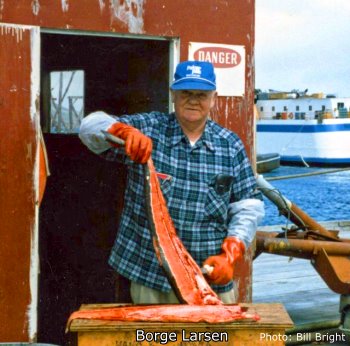
False Pass was incorporated under the laws of Alaska as a 'second class' city in 1990. Around that time, the State was pressuring all areas in the state that were not already in a borough (county), to become boroughs so that they would take responsibility for governance and the public schools. The Aleutians East Borough was then created as the legal mid-level entity, covering False Pass and five other communities in the area.The residents of the village of False Pass at the time had little enthusiasm for becoming a 'city' and to pay taxes. But, under the leadership of Borge Larsen, the City's first Mayor, the legal, political and administrative hurdles were overcome. The most important reasons for becoming a city were to support the public school in False Pass and to begin to build the service infrastructure needed for a modern community. Under Borge's leadership, the city built a new City Office and Rec Center, moved the post office to a new location in the community and began to lay plans for a City Dock and Boat Harbor. Until this time, the village had depended upon the docks, post office, stores etc. at the salmon cannery and had little infrastructure of its own.
Borge was born in Denmark and came to live in False Pass in 1950. His first job was as salmon trap watchman, but in 1951 he became the "winterman" with his uncle Chris Larsen and he watched over the cannery in the off-season when it was closed. During the summers he was the Beach Boss at Peter Pan. He was also the Assistant Post Master when the post office was still in the Peter Pan office. He ran the post office during the wintertime for many years until he retired.
City infrastructure has now been completed for most of the services needed in a modern community. This includes an all weather airport, a city dock that accomodates the Alaska State Ferry and general cargo, a new Boat Harbor, a city-wide water system, fire department, electrical system, library, post office, clinic and public school. Maps showing the location of this infrastructure are on the City page of this website.
The City is governed by a City Council consisting of seven members. The City has a Mayor who also does the work of the administrator. The current Mayor of False Pass is Tom Hoblet.
The City tax rates are as follows:
Sales and Use Tax: 3%
Bed Tax (hotels): 6%
Raw Fish Tax: 2%Current positions in the City administration, as well as much more information about the City, can be seen on the City's website here.
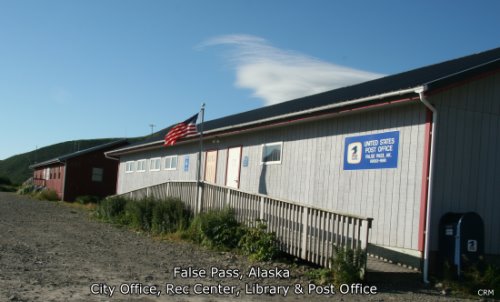
A Bit of History......
The U.S. Mail arrived in False Pass via seaplane after the mail boat service was stopped and until the construction of the airport was finished in about 1962. The seaplane was the Reeve Aleutian Grumman Goose and, depending on the weather, arrived about once a week. On this day it appears that the cannery chartered the plane to take out some workers. Usually the mail plane is met by many local people and their dogs and the postmaster.
In this photo, we see the Postmaster, Bill Bright, holding the U.S. mail sack and the cannery superintendent, Don Rawlinson, in the blue jacket, watching the action. The Beach Boss, Borge Larsen, is seen in the red hat, walking down to the plane.
Usually, everyone pitched in and helped carry the mail to the post office which was located in the cannery office. The seaplane landed right next to the cannery, that can be seen on the right. Click on picture to see a larger version.
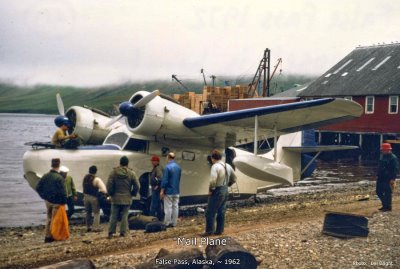
False Pass was a classic Alaskan cannery village until the cannery burned in 1981. The cannery provided all the basic infrastructure for the village, including docks, post office, clinic, radio communications, stores and the first school.
This is the village of False Pass in the 1930's. The local residents lived mostly along the beach, some in cabins on company property in the mid-foreground, but the majority lived "up the beach" starting with the Kristensen residence on the lower left. Two residences had been built very early near the cannery, the Vanner house and the Gardner place.
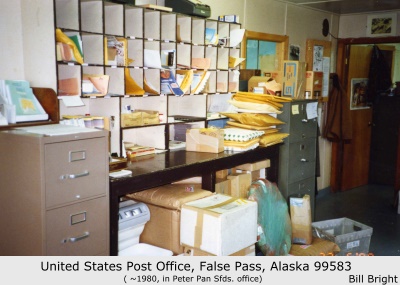
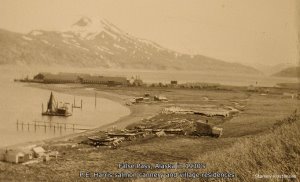
Click on picture for larger version
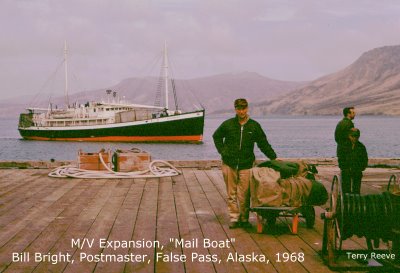
The Mail Boat, Expansion:
The Expansion was built by Northwestern Shipbuilding, Bellingham, Washington in April 1944 for the US Army. She was "Coastal Freighter #FS 244 540". She was sold by the army and re-named the "Dennis Winn". The Dennis Winn was named after an official with the U.S. Fish and Wildlife Service and the vessel carried supplies to the Pribilofs and other USFWS locations before Alaska statehood. Later the vessel was re-named the "Expansion"and began work as a mail boat.
The Expansion served as a mail boat for the Alaska Peninsula and Aleutian Islands and stopped monthly at False Pass to bring the mail and passengers, sailing out of Seward. She also had on board a small store where one could buy fresh produce, ice cream and other perishables. The Expansion was later sold and re-named the "Temehani" and sank in Bora Bora in 1982. 1
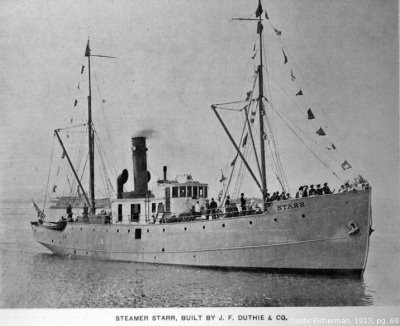
Steamer Starr, Mail and Passenger Service to False Pass:
The old timers often talked about the Steamer Starr that came to False Pass every month for many years. She was built in 1913 by J.F. Duthie & Co. and spent many years of service in southwest Alaska.
A report by the governor of Alaska to the Secretary of the Interior in 1921 states: "Effective with December last, contract was effected under the merchant marine act with the San Juan Fishing & Packing Co.. who now operate the steamer Starr from Seward via Seldovia and intermediate points to Unalaska, and to Nushagak and Dillingham during the season of navigation in Bering Sea. This boat operates on a regular schedule, leaving Seward about the 10th of each month in close connection with the steamers of the Alaska Steamship Co. The steamer Starr is equipped to handle a considerable number of passengers, has a wireless telegraph apparatus, etc., and is giving the Alaska Peninsula excellent service." 2
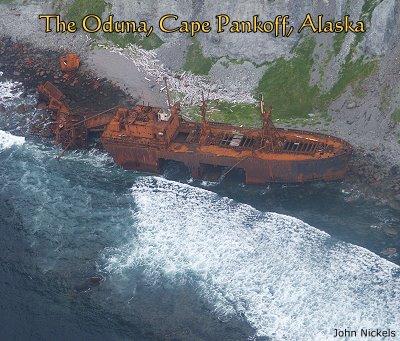
Sea Freight Service to False Pass:
The Alaska Steamship Company out of Seattle provided freight service to much of Alaska, including False Pass, from 1895 to 1971. After World War II, the company purchased a number of "Liberty Ships" from the U.S. Maritime Commission and used them as freighters. Traditionally, the freighter would arrive in False Pass in early spring with much needed supplies for the village and materials for starting up the cannery. Then, another freighter would arrive usually in June to bring more supplies and perhaps more tin for the cannery and take out whatever canned fish was ready. Then, another freighter would arrive after the salmon pack was finished, probably in mid-September, to take out the salmon pack and bring in supplies for the winter. The villagers would place their grubstake winter orders with the cannery bookkeeper to arrive on this last freighter in the fall. The P.E. Harris cannery store received all of its supplies on the freighter to tide the village over until spring. Depending on freight needs for the cannery and village, there were usually no freighters in wintertime.
The Oduna was one of these liberty ships. She was built in 1945 by New England Shipbuilding Corporation, East Yard, South Portland, Maine as Liberty ship type EC-S-C1 for United States Maritime Commission. In 1951 she was sold to Tramp Cargo Carriers, NY renamed Liberty Bell. Then in 1956 she was sold to Polarus SS Co., NY renamed I.R. Lashins. Again in 1957 she was sold to Southport SS Corp., NY renamed Southport. In 1964 she was purchased by Alaska Steamship Co. and renamed Oduna and modified to carry containers. On the 26th of November 1965 she ran aground at Cape Pankof, Unimak Island, Alaska and was a total loss. Cape Pankof is located on the Ikatan Peninsula, about 25 miles south of False Pass. She weighed 7,216 tons. 3
References:
1) http://www.shipbuildinghistory.com/history/shipyards/4emergency/wwtwo/northwestern.htm
2) Report of the Governor of Alaska to the Secretary of the Interior By Alaska. Governor. at: www.books.google.com
3) http://www.theshipslist.com/ships/lines/alaska.htm
